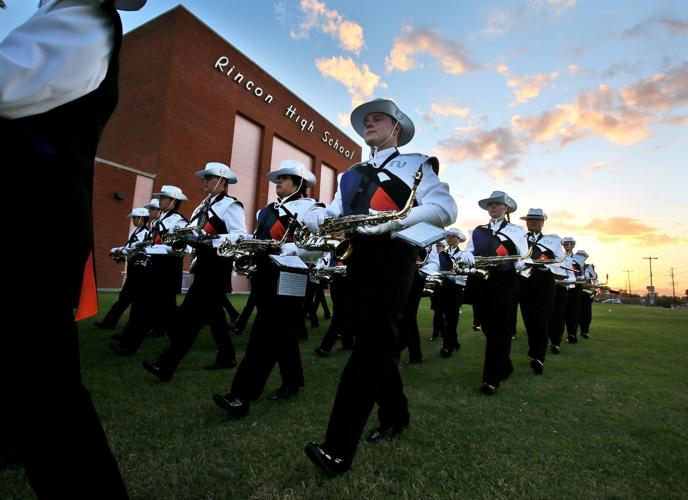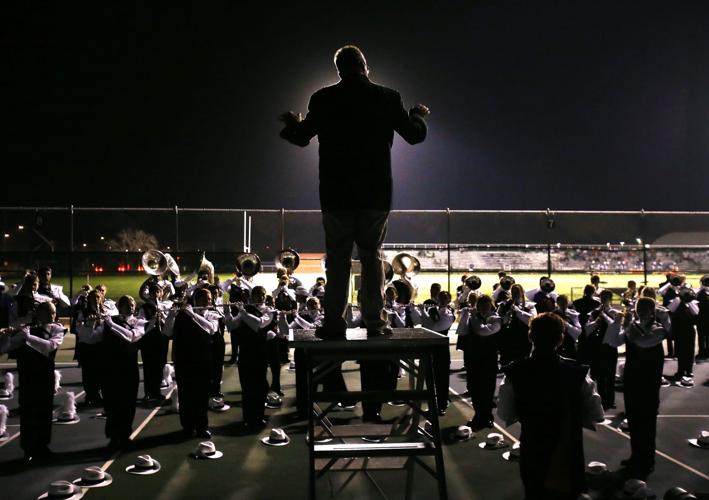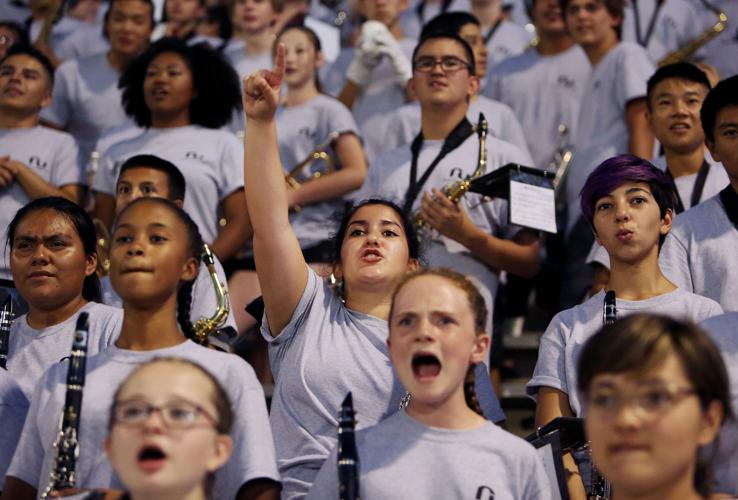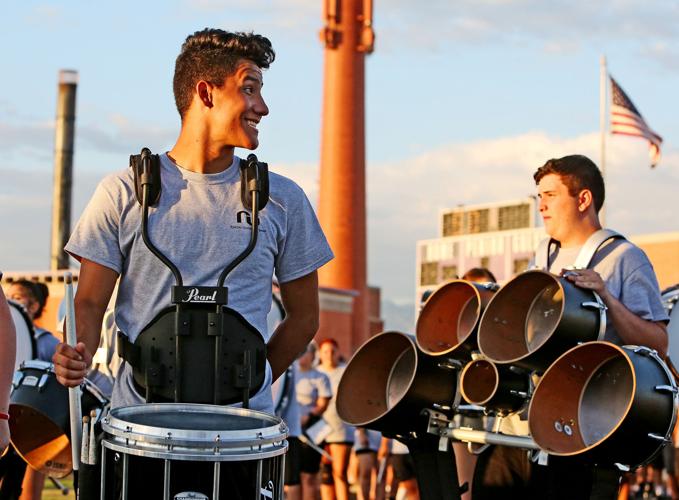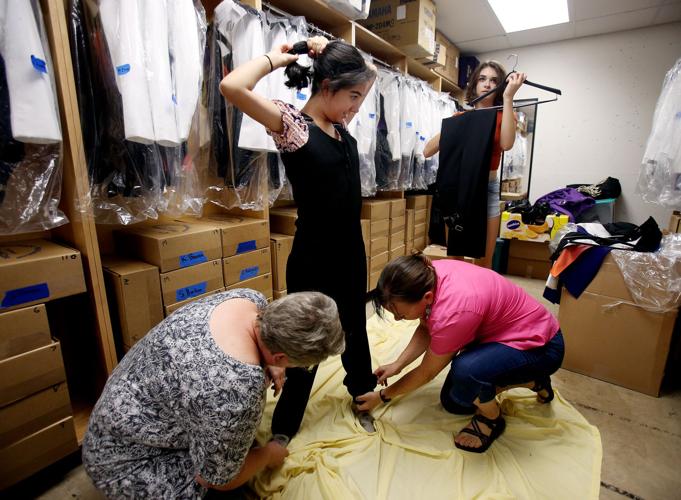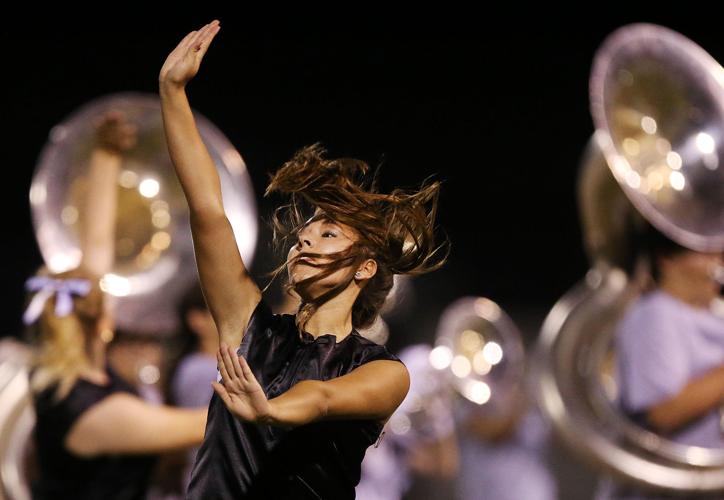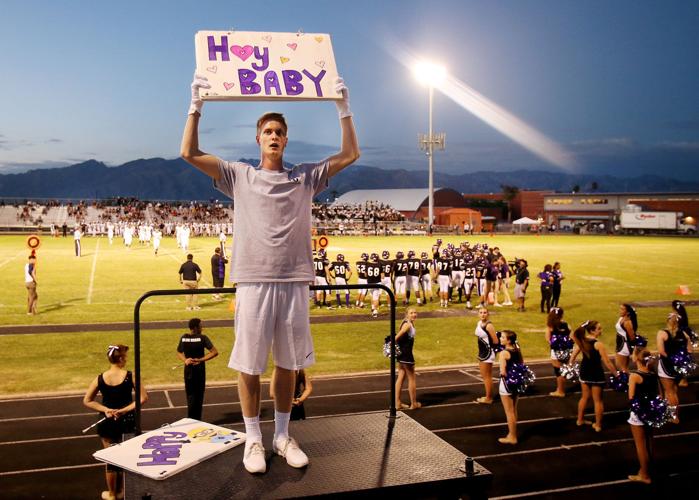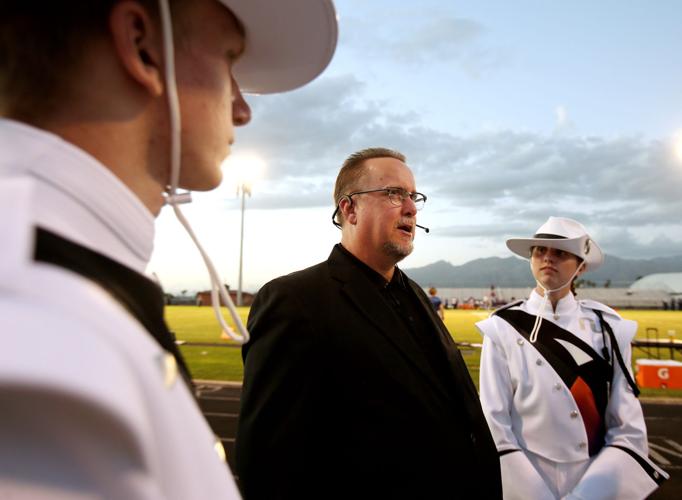Fifteen minutes.
That’s a quarter in high-school football. It’s also halftime.
With nearly two quarters knocked off at the Rincon/University-Mountain View game and halftime looming, the scoreboard reflects a grim night for the home team Rangers: 41-0.
“We would like to thank the football parents for instilling determination in the players and the will to not quit,” the announcer tells the boisterous, mostly teenage crowd.
The kids don’t seem to be paying all that much attention. They’re snapping selfies, spooning neon-colored shaved ice, pouring bottled water over each other’s heads.
Then, the scoreboard clock resets. Fifteen minutes. It’s not just halftime — it’s show time.
The Rincon/University High School marching band, wearing gray T-shirts because the new uniforms didn’t arrive in time for the first home game, fans out across the grass. That’s 197 high schoolers.
“Wow, that’s a lot of kids,” one man in the stadium mutters.
The color guard, outfitted in black and silver floor-length costumes that swish like the flappy curtain of a drive-through carwash, stands among the band members lying on the field in formation.
Gordon Custis, lugging his 27-pound bass drum, quickly runs through the whole show in his head, waiting for his nerves to calm in what will be one of the final performances of the 17-year-old’s senior year.
Gaby Duran, a 15-year-old sophomore, grips her trumpet, feeling excited and overwhelmed by her first halftime show.
“Let’s hear it for the band, ladies and gentlemen,” the announcer calls out. “These students are on their way to becoming masters of their craft.”
Whistles ring out across the field along with a few random shouts.
“BreeeeANNNNNNNNNA!” calls out one young woman with particularly impressive lung power.
“Drum major Zach MacAllister, is your band ready?” the announcer asks.
MacAllister pivots to face the stadium crowd. He salutes.
“You may take the field in performance,” the announcer declares.
Halftime is that 15-minute chunk normally reserved for bathroom breaks and maybe a nachos run.

Band director Jeff Marchant, center, leads the band in warm-ups before a halftime performace at a home football game, Friday night, Sept. 23, The parent support group, Rincon University Marching Band Association, better known as RUMBA, is indespensable. The parents raise tens of thousands of dollars to sustain the band and color guard.
Not here. Not now.
Angelica Sierra will testify to that.
From her perch in the uppermost bleacher, the senior is filming the Rangers so the team can review the game later. She has an eagle’s eye view of the stands.
“People stayed in their seats,” she says after halftime. “No one left for the snack bar.”
She credits the kids with the instruments.
“The band is really cool,” Sierra says. “They play really well, amazing, and for a little time at halftime. They should have their own show.”

Drumline member Antonyo Flores smiles as the Rincon/University High School marching band heads out for a Friday night football game at the school. The band is the largest in the Tucson Unified School District.
The Prep
Truth be told, the band’s not even on the field for the full 15 minutes of halftime. It’s more like 8-10 minutes, a mere blip in a two-hour-plus football game. But that blip takes a lot of preparation.
Flashback to Aug. 15. It’s almost 5 p.m., but the temperature still hovers at 99 degrees with 35 percent humidity, the kind of unpleasant conditions made for clinical-strength deodorant.
Jasmin Garcia sits alone in the stands, hugging the last inches of shade cast by the announcer’s booth. She scans the field for her daughter, Mia, a freshman who plays flute. The Garcias live on the south side. It’s a good half-hour drive from campus, too far to go home and come back, so Garcia sticks around for practice. When the sun drops, she’ll walk the track while she waits for things to wrap around 9 p.m.
The football field blooms with florettes, scraps of plastic grocery bags twisted onto metal stakes that help the high schoolers learn their positions. They march with the sun smack in their eyes.
At this point, the crew has several practices under its belt, as well as a six-day, summer band camp at Northern Arizona University. Work on this year’s show, though, started even earlier. Drafting a performance usually begins in January with band director Jeff Marchant, color guard director Nicole Hamilton and key staffers tossing around ideas.
The band is known for its playful mashups of classical pieces with contemporary tunes and tackles heady subjects. Last year’s show “Uninvited” focused on alienation. This was a time that disadvantage worked in the band’s favor: There weren’t enough uniforms for everyone, so the sax section ended up with its own outfits, echoing the theme of estrangement. This year’s show is called “The Fight.”
Yes, there’s a tinge of that “Rocky” boxing movie, but it goes deeper than that.
“Our only real fight is internal, with ourselves,” Marchant explains. “We compete against our own schedule, our own fear, our own laziness.”
Once a theme and songs are decided, the program works its way to arrangers, who put together the music for the wind instruments and percussion. The cost: around $10,000-$12,000 to write a show, Marchant says.
Formations are plotted, dance moves are choreographed.
Then, it’s up to the kids to put it all together.

Drum major Zach MacAllister signals the next song to the Rincon/University High School marching band during a Friday night football game.
The Marching Band
You don’t need to tell Marchant how underfunded our public schools are. He knows. Oh, he knows.
“Some of our tubas are from 1981,” he says.
That’s 35 years old, for those of you who trust a journalist, with a calculator, to do the math.
A school administrator asked Marchant to tally his equipment needs. He came up with a wishlist close to a quarter of a million dollars. Key word: wish. He’s still relying on Duct tape and Tucson Unified School District’s ace repair guy.
Just the transportation costs alone for TUSD’s biggest band are steep for a cash-strapped district. In fact, this is the first season in 13 years that the band has worn new uniforms. So, Marchant says he’s thankful to have moral support from school administrators and the district, but financial support comes primarily from the parent boosters, who raise $100,000-$200,000 every year to pay for 15 staffers, among other needs.
Despite the lack of funding and resources, the band’s ranks keep growing — so do the honors.
Rincon/University scores top ratings at state competitions and has, four times in the last five years, nabbed the coveted Milton B. Nunamaker Award, which honors the most outstanding group at the annual University of Arizona Band Day.
Bottom line: Kids want to be in the band.
What’s the allure?
Is it the long hours of practice? The possibility of tripping in front of hundreds of people like one poor tuba-toting freshman at the first home game? The chance to wear those not-even-as-attractive-as-bowling-shoes Dinkles marching-band footwear?
They’ll tell you it’s the chance to be part of something bigger.
“I’m not just a dot on the field,” says Katiana Coste, 17 and a senior, who plays the sousaphone.
“Everyone has to participate,” she explains. “Everyone has to work together to get to a place where something magical happens and you remember starting the show and then all of the sudden, you’re marching off the field because everything was second nature.”
You can’t beat the camaraderie, Gordon Custis, the bass captain, says.
“My closest friends are in drumline,” he says. “I trust them with my life.”
The kids in band are incredibly dedicated, says Marchant, who believes in treating the teens like adults, entrusting them with a slew of responsibilities and leadership roles.
“When new staff members come in, what blows them away is the kids,” Marchant says. “They have a really high work ethic.”
While most high-school teachers have students for just one year, Marchant considers himself lucky to teach band members all four years. Nunamakers awards are nice, but to Marchant, this is the real reward: “It’s watching them, seeing them grow up.”

Jacqueline Reaney’s hair goes flying as she performs with the color guard and the Rincon/University High School marching band at the school, 421 N. Arcadia Ave., on Sept. 2.
The Color Guard
When University biology teacher Nicole Hamilton was a student, she was captain of the color guard. Now, she directs it.
“One of the descriptions of color guard that I have always found particularly appropriate is ‘music made visual,’ Hamilton says.
It’s her job to come up with the choreography and costuming that complement the music.
“That program has really grown and taken off,” Marchant says. “When I got here, the color guard was just a bunch of high-school girls with drama.”
The guard’s ranks have also increased over the years, and 39 of the 197 band members are part of the fall group. They rehearse all summer long, with the choreography really gelling by mid-July.
Costume design begins in the spring when Hamilton and her mom begin cutting out fabric, sewing and piecing everything together.
Hamilton says the customized approach makes for a unique appearance and identity. And, not for nothing, it’s also quite cost effective.

Kaitlyn Ramirez, a 17-year-old bass drum player, gets sized up by “uniform mom” Laurie Ellerman, bottom right, and band administrator Karen Spencer, left, as members of the Rincon/University High School band get fitted for their new uniforms. At right is Star Kabisch, a fellow bass drum player.
The Parents
It should come as no surprise that behind the very successful band is a very dedicated group of parents.
The Rincon University Marching Band Association also gets bonus points for a rockin’ acronym: RUMBA.
The parent volunteers chaperone band camp, set up and clean up pre-game meals for the kids, work in the pit crew dragging out instruments, use toothbrushes to scrub out stains on uniforms and basically, just do whatever’s needed — even looking after the other team’s band. At that first home game, Jasmin Garcia was one of several moms and dads sweeping through the 21 rows of bleachers where the Ranger band sits, picking up paper cups and neatly stacking the flip books that hold their music. During halftime, the opposing band takes over the area to watch and then Garcia and the other parents pass out ice water to them.
Last year, nearly 200 thank-you letters went out to parents who’d pitched in, says volunteer coordinator Robin Blumenthal, a pastor whose daughter, Breeann, is a senior clarinet player.
“They’re so self disciplined, I’ve never seen anything like it,” Blumenthal says of the students. She noted that at summer band camp, no teens missed the 7:30 a.m. breakfast report time. “So many parents are so willing to help because we see how dedicated the kids are.”
You’ll always find parents around, says Laurie Ellerman, whose son, Porter, is a senior. Doesn’t matter if it’s a 2 a.m. pickup after a bus breaks down or just hanging around on the sidelines during practice.
“Every once in awhile, a kid will yell, ‘Band mom!’” says RUMBA treasurer Michelle Simon, her son, Tommy, is a junior. “Someone might have a nose bleed or be dehydrated or have sore muscles. Sometimes, they just need a little love and a pat on the back.”

Band director Jeff Marchant has a pre-game talk with the drum majors at a Rincon/University High School football game on Sept. 23, 2016, at Rincon/University High School.
The Director
Jeff Marchant never wanted to be in charge.
When he came on board as an assistant band director at Sabino High School, he was a dad looking for steady income but not a lot of responsibility.
“It was great. I never wanted to be the head guy,” recalls Marchant, a trombone player and father of two boys. His youngest son, Jack, is a sophomore with the band while his oldest son, Miles, is in college.
His second year at Sabino, the band director resigned in the middle of band camp. Marchant found himself in charge — and his perfectionist nature kicked in.
“I can’t stand to do something badly,” says Marchant, whose wife, Donna, knows not to expect him home before 10 p.m. on band practice days.
Declining enrollment at the eastside school made it difficult to build the program, and Marchant started looking elsewhere. Rincon/University was already on his shortlist when the band director job came open. He’s in his seventh year heading up the program.
“I think he really is fabulous,” says Michelle Simon. “Not only is he a great director, but he teaches them to be good people.”
Marchant says he stresses three things to his band: honor your commitments, show initiative and take responsibility for your actions.
A no-nonsense guy, he’s not one to goof around, but he can take a joke. Marchant is so well known for his black top/khaki pants or shorts ensembles — “The fewer choices I have to make in the morning the better” he says of his standard uniform — that twice in recent years, band camp had Dress Like Marchant Day. He did, by the way, find it amusing.
And the fellow who originally wasn’t interested in calling the shots now can’t imagine ever giving it up.
“I’m over 50 years old,” Marchant says. “Three or four times a week I think about retirement, but when I’m standing in front of a group teaching, I feel like I could do it forever.”


